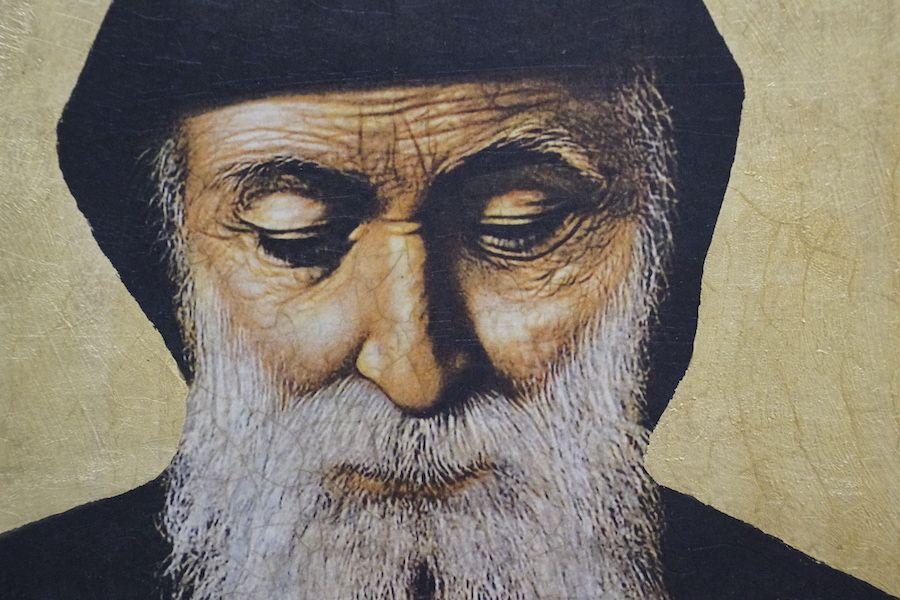Saint Makhlouf was a monk and priest of the Maronite Catholic Church. Venerated in the Latin Rite on July 24, he is known for his rigorous piety, hermitic life, and the various miracles surrounding his life and death.
Born with the name Youssef Antoun in the village of Bekaa Kafra, Lebanon in 1828, Saint Makhlouf was raised in the most pious of families. Following the death of his father while in forced servitude under the Ottoman Turks, his mother remarried a man who would go on to become the parish priest of Bekaa Kafra. With two of his uncles already living as hermits, young Youssef was given three holy role models during his upbringing.
During his youth, Youssef was responsible for the care of his family’s cows. He was known to drive his herd to a nearby grotto, where he had set up a small altar to the Blessed Virgin, and pray until sundown.
At the age of twenty-three, the young Youssef left home without a word, as his mother wished for him to marry and he desired to instead live a life devoted to God as a monk.
After arriving at the Monastery of Our Lady in the town of Mayfouq, he took the name Charbel, after Saint Charbel the Martyr. He would go on to give his vows at the Monastery of Saint Maron, and enter into the study of theology and philosophy at the Monastery of Saints Cyprian and Justina, where he would also be ordained a priest. After his studies, Brother Charbel returned to Saint Maron, and lived the next sixteen years of his life there.
His life-long wish of following the example of his uncles in the eremitical life was finally granted in 1875, when a miracle occurred. In good fun, his fellow monks played a prank on him, replacing the oil in his lamp with water so that it would not burn. To the surprise of everyone, however, the water did indeed burn.
Recognizing the significance of this event, his superiors finally granted his years-long requests to become a hermit. At the age of forty-seven, Charbel became a hermit at the Hermitage of Saints Peter and Paul. He remained here for the rest of his life, suffering a stroke and passing into the hands of the Lord whilst offering Maronite Divine Liturgy in 1898.
Throughout his whole life, Saint Charbel performed a great deal of miracles. He healed many sick people in his life, cured a woman of infertility so that she and her husband may conceive, and was even known to have commanded animals such as locusts and snakes. The miracles of Saint Charbel did not end at his death, and continue to occur in quantities thought impossible.
Only a few months after his passing, a bright light was seen emanating from his grave, which remained radiant for forty-five days. Upon inspection, his body was found incorrupt, meaning it had not suffered the decomposition standard to a cadaver of this age. Indeed, his body remained fully flexible, “as if it were alive.”
What was also found in his coffin was shocking: the Saint was drawing blood and sweat from every pore of his body, and continued to do so at such a rate that the coffin needed regular replacement.
Despite the great radiance surrounding his tomb dimming after forty-five days, his incorrupt body remained so for many years, even outlasting his original tomb which was described as having rusted away.
It was only in 1976 that Saint Makhlouf’s body was found to have decomposed, but even in this, it did so completely and perfectly: only his skeleton remained. It is sometimes thought that this is correlated with the beginning of the Lebanese Civil War the previous year.
Still, miracles surrounding him occurred long after even this. Reflecting the miracles he performed during his life, thousands have reported healing after visiting his shrine or asking him for his holy intercession.
One such case is Sister Maria Abel Kamari, who suffered many ailments of the intestines, kidney, and liver, as well as partial paralysis of the hand. She received extreme unctions on three separate occasions and was nearly always on the precipice of death. In July 1950, after living for fourteen years bedridden, she asked to be taken to visit the grave of Charbel, where she was immediately healed of all of her ailments after a short prayer.
This event, along with the healing of another man’s blindness near the end of the same year, led to Pope Saint Paul VI’s beatification of Saint Charbel in 1965, and a case of miraculously cured throat cancer additionally led to his canonization in 1977.
To date, thirty-three thousand confirmed miracles have been reported to the Monastery of Saint Maron. This, along with the many performed in life, alongside his unwavering devotion to his eremitical vows and the Blessed Virgin, makes Saint Charbel Makhlouf one of the greatest saints of our age.
Intrigued readers may continue learning about the miraculous life and death of Saint Charbel Makhlouf at the websites of the following organizations:
Family of Saint Sharbel USA
Charbel.org
Marcharbel.com

